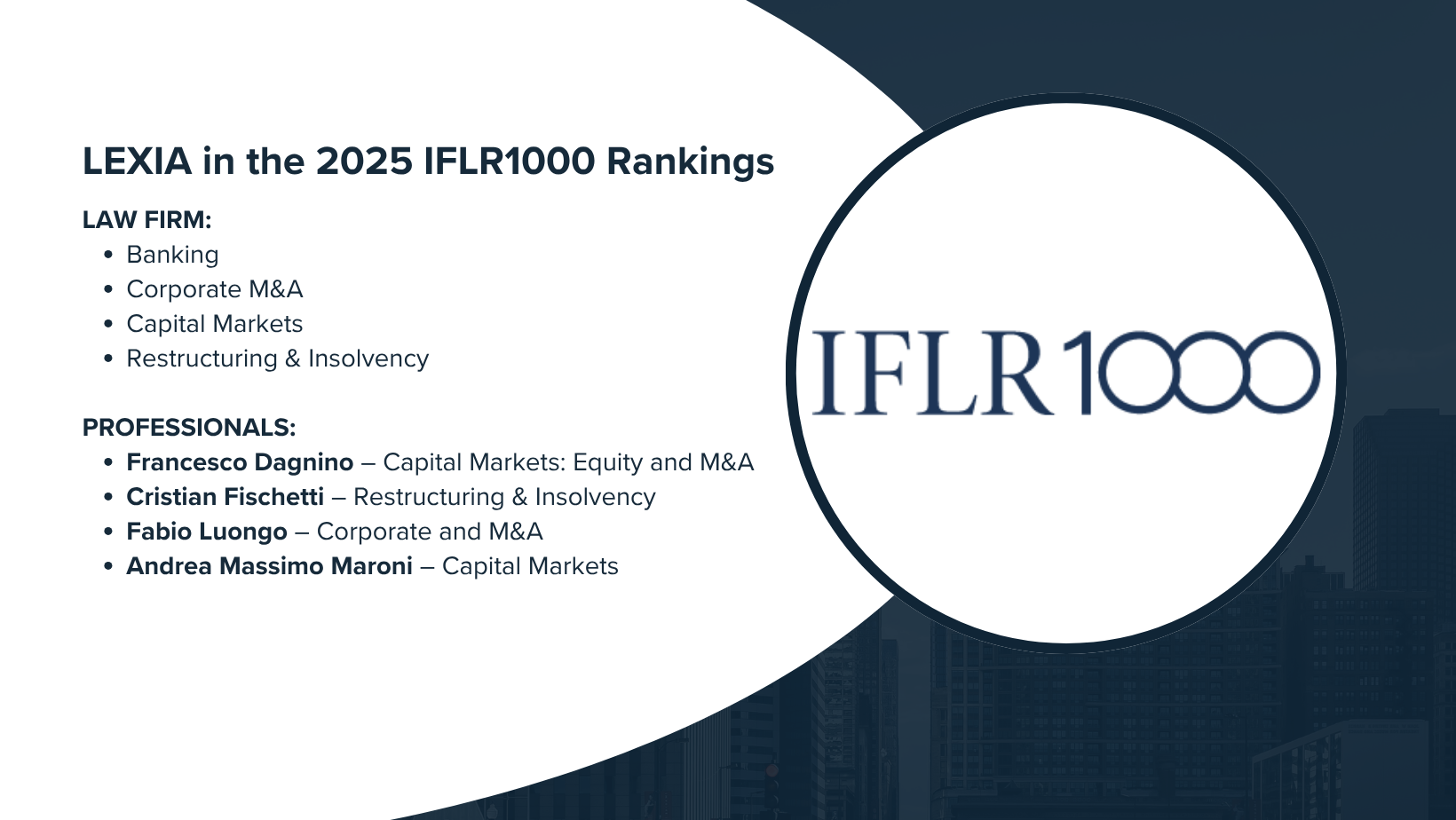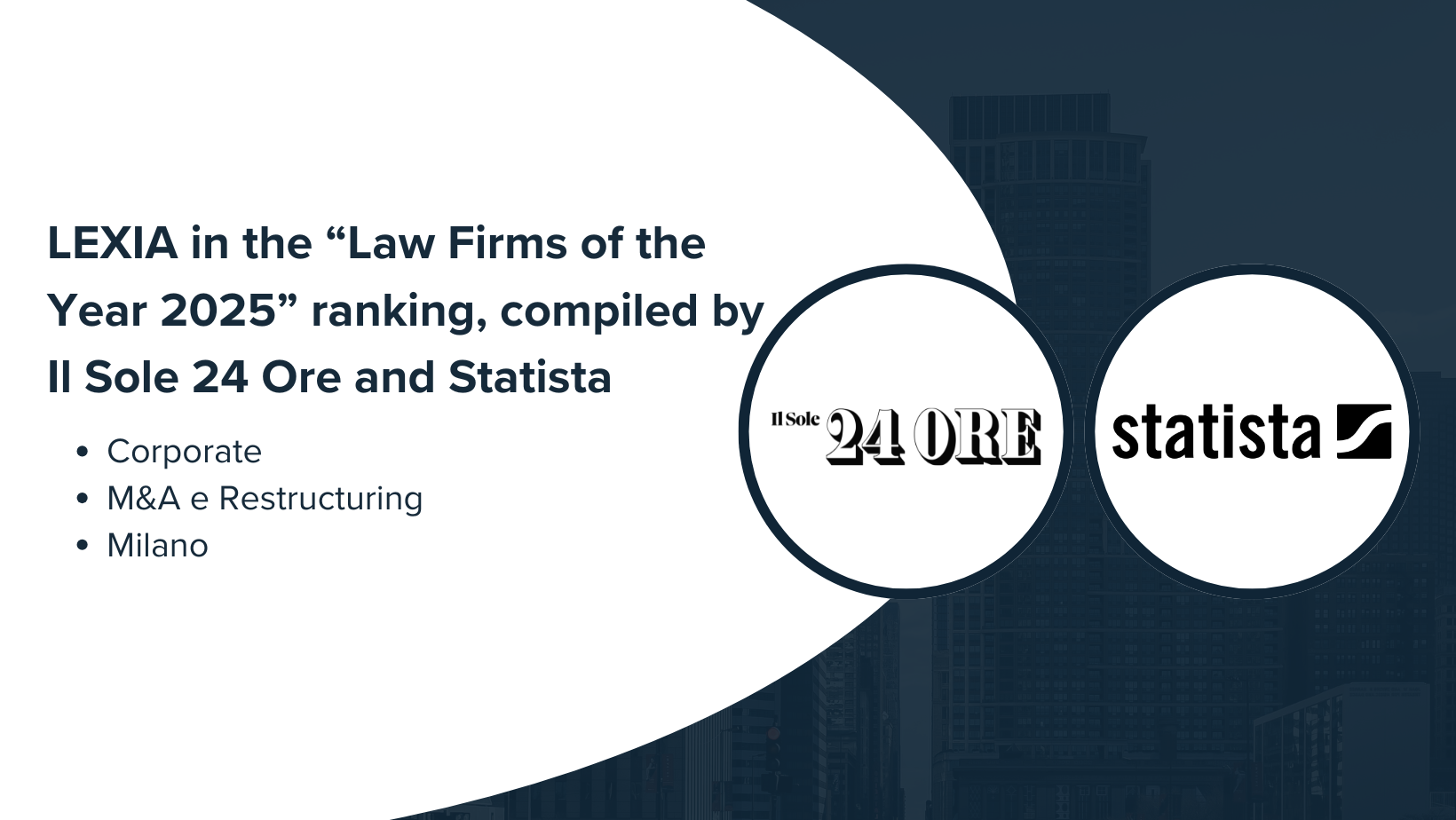This contribution analyzes the legal framework of the avoidance action, providing general information and examining the main legislative changes introduced by the Italian Business Crisis and Insolvency Code, and subsequently by the Third Corrective Decree.
1. Introduction
The institution of the revocatory action (azione revocatoria) in insolvency proceedings, long the subject of extensive debate in case law and legal scholarship, can be divided into two distinct types: the “ordinary” revocatory action (Articles 2901 et seq. of the Civil Code and Article 165 of the Italian Insolvency Code – CCII), and the revocatory action “in judicial or bankruptcy liquidation” (Articles 166 et seq. CCII, which also include the provisions set forth in Articles 163–164 CCII).
Starting with the former, the ordinary revocatory action is grounded, as mentioned, in Article 2901 et seq. of the Civil Code – which also applies in insolvency proceedings pursuant to the reference in Article 165 CCII – and is characterized by the necessary presence of a subjective requirement (consilium fraudis) and an objective requirement (eventus damni).
Consilium fraudis can be classified into two different situations, depending on the timing of the debtor’s act in relation to the emergence of the creditor’s claim: (i) awareness of the harm that the act would cause to the creditor (ex post assessment relative to the creation of the credit), and (ii) fraudulent intent preordained to the execution of the act (ex ante assessment). For evaluating the subjective requirement, the nature of the transaction is particularly important, as it significantly affects the burden of proof: if the act is for consideration, it suffices to prove the debtor’s consilium fraudis; if the act is gratuitous, the presence of consilium fraudis on the part of the third party receiving the asset also becomes relevant.
Regarding the eventus damni, it refers to situations where the harmful act has hindered the creditors’ ability to satisfy their claims, causing an insufficiency in the debtor’s estate.
Specifically, the revocatory action in judicial liquidation is the tool that allows the receiver (or equivalent figure) to safeguard the par condicio creditorum through a targeted action aimed at restoring to the debtor’s estate, in the context of insolvency proceedings, all those acts that, according to the legal requirements, are deemed “prejudicial to creditors.” In line with this principle, the debtor’s estate must be reconstructed by rendering ineffective all acts that favor one creditor to the detriment of the others.
This instrument finds its legal basis in Article 166 CCII, which, in its first paragraph, provides that “acts for consideration, payments, and guarantees” falling under certain categories “shall be revoked unless the other party proves that they were unaware of the debtor’s insolvency.” The concept of knowledge of insolvency (scientia decoctionis) is a rebuttable presumption (iuris tantum) that the third party was aware of the debtor’s insolvency at the time of the transaction.
The revocatory action in judicial liquidation also includes the concept of the suspect period, which is the timeframe during which the debtor may have performed asset-disposing acts that harm creditor interests. Therefore, if an act deemed revocable under the law was carried out during this period, it may be declared ineffective or subject to judicial revocation.
Naturally, all acts, whether ordinary or extraordinary, performed after the reference date are considered to have occurred during the suspect period.
2. Avoidance action: from bankruptcy law to the CCII
In continuity with the provisions of the previous Bankruptcy Law (Articles 63 et seq. L.F.), the comprehensive reform introduced by the Italian Business Crisis and Insolvency Code (Articles 163 et seq.) mirrors the rules relating to the effects of judicial liquidation on acts that are detrimental to creditors’ rights, with the aim of implementing the principle of par condicio creditorum.
In this context, the most significant innovation introduced by the Code is the new method for calculating, retroactively, the so-called suspect period. This period must now be calculated not from the date of commencement of the insolvency proceeding (formerly, the date of the declaration of bankruptcy), but from the date of filing of the petition that resulted in the opening of judicial liquidation. This concept has been applied in various provisions of Section IV, Chapter I, Title V of the Crisis Code, in order to ensure that the time elapsing between the filing and the opening of the procedure does not harm creditors by making older transactions irrevocable.
Conversely, this change has made it more difficult for creditors to assess in the abstract whether a previously received payment may be subject to revocation, since the date of filing of the petition that triggered the judicial liquidation is not always immediately known.
Under the rules set forth by the Code, the same categories of revocable acts are confirmed (acts ineffective ex lege, Articles 163–164, and acts requiring judicial determination, Articles 166(1)(2), 167, 168, and 169), although there are also innovative elements, such as the rule establishing ex lege ineffectiveness of payments made in advance of their due date (Article 164(1) CCII).
With regard to acts whose ineffectiveness must be established through judicial proceedings (acts for consideration, payments, and guarantees), the Code closely follows the previous regulation under Article 67 of the Bankruptcy Law (Article 166 CCII), maintaining the distinction between so-called “abnormal acts” and “normal acts.”
3. Procedural issues: time limits, standing, and jurisdiction
As for procedural aspects, the time limits for bringing an action are set out in Article 170 of the Italian Code of Business Crisis and Insolvency (C.C.I.I.). Paragraph 1 provides that revocatory actions may be brought within 3 years from the date of filing of the petition for the opening of judicial liquidation, and in any case no later than 5 years from the date the act was carried out. The provision further specifies that, when a petition to access a crisis or insolvency resolution instrument leads to the opening of judicial liquidation, the reference date for calculating the suspect period and for exercising the revocatory action shall be the date of publication of the access petition, rather than the date of the court ruling opening liquidation.
However, this general rule has exceptions when the insolvency proceeding differs from judicial liquidation.
In fact, in the case of extraordinary administration of large insolvent companies, the prevailing case law holds that the limitation period for initiating a revocatory action begins with the approval of the program for the sale of business assets and not from the court decision declaring insolvency or from the appointment of the extraordinary commissioner. This interpretation is based on Article 49 of Legislative Decree No. 270/1999, which states that the revocatory action may be initiated by the commissioner “only if the execution of a program for the sale of business units has been authorized,” thereby establishing a specific condition precedent for exercising such action.
An even more complex situation arises in the case of compulsory administrative liquidation, where Article 299 C.C.I.I. applies. Paragraph 1 equates the date of filing of the petition for judicial ascertainment of insolvency with the date of filing the petition for opening judicial liquidation.
As far as standing is concerned, a distinction must be made between active and passive standing.
Firstly, the only party entitled to bring a revocatory action is the trustee (curatore) or equivalent figures in procedures other than judicial liquidation, such as preventive arrangement (concordato preventivo), simplified arrangement, compulsory administrative liquidation, or extraordinary administration. In the case of a composition agreement within judicial liquidation, the assignee (assuntore) who assumes all the obligations arising from the agreement in exchange for all the assets of the procedure (including previously initiated revocatory actions) is entitled to succeed the trustee in the disputed right pursuant to Article 111 of the Italian Code of Civil Procedure.
It is important to note that active standing must be accompanied, as in any ordinary proceeding, by a legitimate interest in bringing the action (Article 100 of the Code of Civil Procedure), since the revocatory action does not necessarily presume damage and serves a distributive function in favor of creditors, respecting the principle of par condicio creditorum. Therefore, before initiating a revocatory action, one must assess whether the act has actually harmed the collective interests of the creditors.
Regarding jurisdiction, this has been significantly modified by the entry into force of the Crisis Code.
While there were never any doubts that revocatory actions in bankruptcy (Article 67 of the Bankruptcy Law) fell under the exclusive and mandatory jurisdiction of the court where the bankruptcy was declared (under Article 24 L.F.), the same cannot be said for ordinary revocatory actions. In the case of an ordinary revocatory action brought by a bankruptcy estate under Article 66 L.F., case law questioned whether an exception should be made when the revocatory action concerns a corporate demerger, which by nature might fall under the jurisdiction of the specialized corporate sections of the court.
This issue was recently addressed by the United Sections of the Italian Supreme Court (Cassazione), which ruled that the ordinary revocatory action under Article 66 L.F. concerning a corporate demerger falls under the jurisdiction of the bankruptcy court, which takes precedence over that of the corporate section. However, this ruling came late, as the Crisis Code—already in effect for nearly three years—had already defined jurisdiction for both ordinary and judicial liquidation revocatory actions under Article 27. That article (i) assigns jurisdiction to the specialized corporate section for disputes involving companies eligible for extraordinary administration or corporate groups, and (ii) assigns residual jurisdiction to the court where the debtor has its center of main interests (COMI).
As a result, the Supreme Court’s decision will apply only to proceedings initiated under the previous Bankruptcy Law, and will have no bearing on proceedings commenced after the Crisis Code came into force.
4. Judicial liquidation avoidance: ineffective and revocable acts
4.1 Ineffectiveness of gratuitous acts and payments of unmatured and subordinated debts
These two types of acts subject to revocatory action, governed by Articles 163–164 of the Italian Code of Business Crisis and Insolvency (CCII), differ from those outlined in Article 166, as they are void by nature (also known as “ineffective by law” or “tainted by absolute irregularity”).
Their distinctive feature lies in the declarative nature of their legal invalidity, as they are null and void ipso iure if carried out within the suspect period, and the knowledge of the debtor’s insolvency (scientia decoctionis) is presumed iuris et de iure. It is important to note that although revocation is automatic, the trustee may still initiate legal proceedings for revocation if restitution is not voluntarily made or when it is necessary to obtain a judicial title.
Specifically, Article 163(1) declares void gratuitous acts carried out within the two years preceding the filing date of the petition that led to the opening of judicial liquidation, and thereafter. Paragraph 2 of the same article excludes from the previous provision customary gifts and acts performed in fulfillment of a moral duty or for public utility, provided they are proportionate to the donor’s assets.
Article 164(1) of the CCII qualifies as legally ineffective any payments made before their due date—such as early repayment of a loan—if the obligation’s due date falls on or after the day the judicial liquidation is opened (not the day the petition was filed, thus diverging from previously applied reference dates), provided the payments were made either after the petition or within the previous two years.
Unlike the previous Article 65 of the Bankruptcy Law, the CCII adds two more paragraphs to this provision to regulate the matter more thoroughly. Paragraph 2 of Article 164 incorporates what was already stated in Article 2467(1) of the Civil Code, declaring void against creditors any repayments of shareholder loans made after the filing of the petition that led to the opening of insolvency proceedings or within the year before that date. The same rule applies to repayments of loans made in favor of the company by entities exercising management and coordination functions or other related parties (Article 164(3), CCII).
4.2 Revocable acts: onerous transactions, payments, and guarantees
The revocatory action in judicial liquidation is governed by Article 166 CCII, which states in paragraph 1 that “the following transactions are revoked, unless the counterparty proves that they were unaware of the debtor’s insolvency”:
(i) Onerous contracts that are disproportionate—i.e., those where the value given to the debtor exceeds what was received by more than one-fourth—if carried out after the filing of the petition that led to judicial liquidation (para. 1, no. 1);
(ii) So-called abnormal payments, if carried out after the petition or within the previous year (para. 1, no. 2);
(iii) The granting of pledges, antichreses, and voluntary mortgages after the petition or within the previous year for unmatured pre-existing debts (para. 1, no. 3);
(iv) The granting of pledges, antichreses, and both judicial and voluntary mortgages after the petition or within six months before for matured debts (para. 1, no. 4).
For these categories of acts, the law establishes a legal presumption that the counterparty was aware of the debtor’s insolvency, thereby relieving the trustee of the burden of direct proof and placing the burden on the counterparty to prove otherwise.
Paragraph 2 of Article 166 refers instead to (v) so-called normal acts, i.e., all onerous acts, payments, or guarantees related to matured and payable debts carried out by the debtor using cash or another standard payment method, provided they were performed after the petition or within the previous six months. In these cases, the burden of proof regarding the counterparty’s knowledge of insolvency (scientia decoctionis) lies with the trustee.
To fully grasp the above, one must first analyze the concept of knowledge of insolvency (scientia decoctionis) and, in particular, the counterproof allowed to the defendant (inscientia decoctionis).
The trustee may prove the counterparty’s knowledge of insolvency either directly—using evidence such as press articles, affidavits, etc.—or through presumptions, as long as these are serious, precise, and consistent (Articles 2727–2729 Civil Code), proving actual rather than potential knowledge. If the counterparty is a third party to the contract, knowledge must be demonstrated through connections and facts showing that a prudent operator under the given circumstances could not have failed to notice the debtor’s financial distress.
Conversely, the defendant must prove their lack of knowledge (inscientia decoctionis) as of the moment the revocable act was carried out. Consistent case law states that even in cases of legal presumption, the defendant must provide specific and concrete evidence showing that a reasonably prudent person would have considered the business situation to be normal at that time, and mere ignorance is insufficient.
Let us now analyze each type of revocable act in detail:
(i) For acts that are disproportionate by more than one-fourth, the trustee must assess whether the disproportion existed at the time the act was performed or the contract concluded—not when the revocatory action is brought. Subsequent events leading to an increase or decrease in the disproportion are irrelevant.
(ii) As for so-called abnormal payments, the concept has been debated. The conclusion is that abnormality lies in the complexity of the payment mechanism used, which deviates from standard commercial practices.
According to the courts, abnormal payment methods are those where cash serves not as a direct and immediate payment method, but rather as the indirect result of other transactions. This rests on the principle that extinguishing a debt through non-standard means often signals the debtor’s financial distress and the creditor’s awareness of such a state, who seeks satisfaction nonetheless.
(iii) and (iv) Regarding the establishment of guarantees, these can be analyzed together, as the difference lies in whether the debt in question was due and payable when the guarantee was granted.
Both are listed in paragraph 1 of Article 166 (formerly Article 67 of the Bankruptcy Law). Jurisprudence states that these are only revocable if granted for consideration (iuris tantum presumption of being onerous). If gratuitous, depending on the type of guarantee (e.g., surety, pledge, mortgage), they would fall into the category of so-called normal acts.
Recently, the Supreme Court clarified, in a case concerning bankruptcy revocation, the meaning of „matured debt“ when a payment deferral agreement has been entered into. It held that if a guarantee (in that case, a mortgage) is given after the original payment deadline was missed, the debt is to be considered matured for the purposes of Article 166(1)(4) CCII—even if the parties simultaneously agree on a new payment schedule— provided there is a teleological link between the deferral and the granting of the guarantee.
(v) Lastly, so-called normal acts form a broad category of revocable transactions. It is logical to assume that a debtor might have carried out numerous acts during the suspect period while still conducting business. It is the trustee’s duty to assess whether those acts harmed the creditors and to prove the counterparty’s knowledge of the insolvency.
This category includes all prejudicial acts not covered by paragraph 1 and not falling within the exempt acts outlined in paragraph 3.
5. Acts exempt from avoidance
Lastly, we must not overlook the categories of acts exempt from revocatory action, as specifically listed in Article 166, paragraph 3, of the Italian Business Crisis and Insolvency Code (CCII), which underwent significant changes with the 2022 reform, although most grounds for exemption from revocation were confirmed.
Letter a) identifies payments for goods and services made in the ordinary course of business, within so-called “customary terms.” According to established case law, this exemption does not extend to the goods or services themselves but exclusively to the payments deriving from them, and only insofar as they reflect the commercial relationship between creditor and debtor. Given the thin line between a normal/abnormal act and one made in customary terms, case law has clarified that exempted payments are those typically used and originally agreed upon between the parties, and not irregular practices.
This exemption applies exclusively to payments related to “supply” contracts—those that clearly express or relate directly to the debtor’s business activities, excluding transactions that are not connected to such activities.
Moreover, the Supreme Court recently ruled that this exemption does not apply to payments made under a “repayment plan” agreed upon following a failure to fulfill the original obligation on time.
Letter b) refers to payments made into a current account. Notably, the requirement of „substantiality“ (consistenza) of payments has been removed, with only the “durability” (durevolezza) requirement now remaining in the CCII. The legislator found that assessing “substantiality”—a relational value determined case by case—left too much room for interpretative discretion. Some courts had used a percentage-based threshold (e.g., based on the debtor’s average overdraft during the suspect period), others looked at the so-called „repayment“ under Article 70 of the Bankruptcy Law (now Article 171(3) CCII), while still others focused on the average value of the payments compared to the average account balance.
Removing the „substantiality“ requirement helps eliminate interpretive discrepancies without reducing the scope of the exemption, since the goals of protecting assets not truly harmful to the debtor’s estate and preserving par condicio creditorum are still fulfilled via the “durability” test and the limitation in Article 171(3).
Letter c) includes as exempt final or preliminary sale contracts entered into “at fair value” for properties used as the debtor’s primary residence or business premises. The rationale is to protect good-faith purchasers—even those with knowledge of the insolvency—provided the price paid is fair and reflects market conditions at the time of sale. Otherwise, the transaction may fall under disproportionate consideration under Article 166(1)(1).
Letter d) covers acts and payments made pursuant to certified recovery plans. The CCII introduced a provision stating that this exemption does not apply “in cases of fraud or gross negligence on the part of the certifier or the debtor, if the creditor was aware of such misconduct when the act, payment, or guarantee was made.” These acts are also exempt from ordinary revocatory actions, thereby encouraging broader use of crisis resolution tools.
Letter e) introduces a significant innovation compared to the previous Bankruptcy Law: the protective “umbrella” available for pre-bankruptcy arrangements and restructuring agreements now also applies to ordinary revocatory actions, not just to bankruptcy-based ones. Moreover, the recent Decreto Correttivo-ter (Legislative Decree No. 136 of 13 September 2024) filled a legislative gap by extending this protection to acts carried out under simplified composition with creditors (concordato semplificato), which was previously omitted.
Letter f) exempts payments made by the entrepreneur as compensation for work performed by employees and other collaborators, including non-subordinate workers. Case law has clarified that this exemption covers freelance workers if their services were provided continuously and with coordination. However, employment agencies are excluded, as their claims are commercial rather than labor-related.
Lastly, some acts are excluded from revocatory action in judicial liquidation not by the CCII, but based on case law or special laws.
One such case is the rotating pledge, which courts have ruled cannot be revoked if the original act establishing the pledge, satisfying the requirements of Article 5 of Legislative Decree No. 17 of 21 May 2004, was made outside the suspect period.
This is because the replacement mechanism typical of such guarantees does not amount to a new guarantee, provided that: (i) it is in writing with a certified date under Article 2704 Civil Code; (ii) the pledged item is delivered; and (iii) the replacement item has equivalent value. If these conditions are not met, each act of substitution would be treated as independent and revocable based on when it was carried out.
The Supreme Court has also ruled on factoring, stating that the exemption in Article 6(1) of Law No. 52 of 21 February 1991 applies only to ordinary payments made by the assigned debtor to the assignee as part of the factoring contract under Article 67(2) of the Bankruptcy Law, and not to abnormal payments under Article 67(1)(2) (now Article 166 CCII).
Full article available on Diritto Bancario >
All references to case law and statutory provisions are footnoted in the original Italian version.






